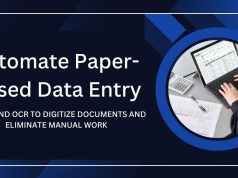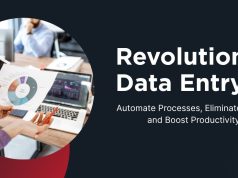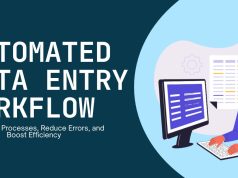No longer do we spend hours upon hours typing, correcting and organizing data. With the automation of data entry, businesses are changing how they deal with their data, choosing a more intelligent, quicker and more secure alternative to completing mundane work. But, how to do this in practice? But perhaps more importantly – what sort of impact can it have on your business?
This article delves into the notion of data entry automation, looks at the limitations of the traditional approach, as well as discusses the advantages and practical applications of automation. As a decision maker, a data person, or someone with an interest in the future of work, find a whole lot of valuable nuggets in here.
What is Data Entry and Why is it Important?
Primarily, data entry involves filling forms and registration on some sites or typing material from one format to another, reports, papers, contents etc. Every industry relies on it, as a cornerstone of decision making, customer management, inventory management and much more.
Efficient data entry is the key to a successful business, and the slightest mistake in this area can cause expensive problems. However, the use of old techniques for data entry have been very ineffective and hence present a loss to the companies as they look for new alternatives.
The Downside to Manual Data Entry
Manual inputting of data has worked well for years, if it’s slow and arduous work. But there’s plenty not to love:
Human Error
There’s always the potential for typos, for the numbers to be formatted the wrong way, or for data to be misinterpreted by hand. These errors affect the whole database quality, and the decisions taken can be significantly flawed.
Time-Consuming Processes
Typically, workers can spends hours doing mundane tasks like transferring information from paper forms into a spreadsheet. And you could otherwise be spending your time on high-value, tactical action.
Cost Inefficiency
Manual data entry would often involve assemblage of a massive task force to accomplish tasks efficiently, which in turn inflates labor costs without guarantee of accuracy and scalability.
Employee Burnout
’” ‘If it’s the same tedium every day, and you’re treating every task with as much sense of urgency, and you have no better way to prioritize, that’s when people get frustrated and leave.’” Lack of a variety in tasks can frustrate employees and lessen job satisfaction and potentially cause turnover, according to Watson.
Evidently, these problems draw attention to the requirement of an automatic solution that reduces manual operations at the same time ensuring efficiency and precision.
What Do We Mean by Data Entry Automation?
Data entry automation is the process where high-end technology, including AI, ML, and RPA, automate data entry job. Rather than needing people to give them input, inputting data manually, automation tools are pulling, retrieving, and inputting data at speeds hard to fathom, with far fewer errors than the typical human inputs.
Automation tools can take care of all sorts of jobs, such as invoicing, data extraction from PDFs and copying information between applications — without needing a human to get involved.
Pros of Automated Data Entry
The advantages of the automatic input of data should not be restricted to faster processing. Here’s what makes it a game-changer:
-
Improved Accuracy
By using preset rules and algorithms, data is managed by automation, so there’s no room for human error. So the higher the accuracy rates, the cleaner the data sets businesses can depend on to shape strategy and make decisions. -
Faster Turnaround Times
Automated abilities allow tools to parse mountains of data in minutes, completing tasks that would take days or weeks for human teams. -
Cost Savings
Automation tools have an initial cost, but they save you in the long run by reducing labor costs, increasing efficiency, and reducing errors. -
Enhanced Productivity
Reducing the burden for employees to repeatedly input the same data allows them to spend their time on more meaningful, high-impact work, which increases productivity and satisfaction. -
Scalability
As businesses scale, manual data entry is no longer feasible. This can be scaled even further as automation allows a business to deal with large amounts of data without massively increasing their resources.
Data Entry Automation? Action File. List Ending Manual Data Entry Once and For All!
Ready to take your data entry processes on autopilot? Here are the three easiest ways for you to get started:
Assess Your Existing Data Entry Procedures (Point to Ponder)
What parts of your data entry process are the most painful or error-prone? Identify places where automation could make the biggest difference.
Selecting the Right Tools for Automation
We have plenty of tools that aim to automate data entry — tools like Zapier, UiPath and ABBYY FlexiCapture. Choose a tool which will best meet your specific requirements – whether that’s extracting information from invoices, entering it into a CRM or connecting up applications.
Train Your Team
Train your people to use automation tools the right way. Despite being easy to use in concept, knowledge of what they can do is key to driving adoption They do not customize information, but they can help direct information disposal programs accurately and effectively.
Begin small and scale slowly
To test the effectiveness of automation in your process, you can start with a small pilot. When you’re happy that it works, roll it out elsewhere in your operations.
Monitor and Optimize
Monitor your automation tools performance on a regular basis to check for areas to optimize. Most tools have data and analytics you can use to refine your processes as you go.
Examples of Real World Data Entry Automation
Still skeptical? Here are some real companies who have reaped the rewards of automating their data entry:
Streamlined Ordering – Where to Order Online?
An online shop lost time due to having to manually handle customer orders. With an RPA service, they automated their order entry, so they could handle thousands of orders per day with few errors. As a result, TAT was reduced by 50%.
Healthcare Provider – Decreasing the Number of Patient Record Errors
A provider extracted and entered data from patient forms using machine learning software. Data accuracy increased, while staff time saved reached 40% in medical professionals’ paperwork.
Logistics Company – Streamlining an End-To-End Fleet Management Solution
An app development company that specializes in logistic and navigation software approached Volga Tigris to develop a unified solution to optimize and manage their fleet.
Airmoji suggested timesaving measures for a supply chain company, like automatically inputting data on vehicle tracking and fuel consumption logs. It was time to reverse the trend. The process automation installed in their database allowed them to save hundreds of hours per month and, most importantly, grant real-time visibility into fleet operations for performance optimization.
The Future of Data Entry
Automation of the data entry process is no longer a nice-to-have but a must-have in this fast-paced, information-driven world. With further evolution of AI and ML, the future holds an even greater potential for exciting developments like real-time data integration and predictive analytics.
With automated data entry, businesses are able to be more accurate, save money, and offer employees more time to do higher-level tasks. The result? An organization that is more nimble, competitive and ready for the future.
If you’re new to paid search, our beginner’s guide on Google Ads automation explains the basics and highlights effective keyword strategies to maximize your campaigns.”










